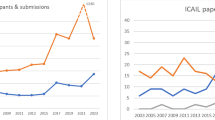Abstract
The paper defends an interactive theory of the distinctiveness of criminal law. It argues that criminal law’s distinctive behavior can be connected to the interaction between five traits: it is an institutional practice administered by a large and special bureaucracy, playing a substantial role in authorizing the use of coercive police force, leading to a harsh sanctioning regime linked, at least in part, with core wrongs and notions of personal responsibility. Although none of these features is exclusive to criminal law, their interaction leads to modes of behavior that set it apart from other institutions. The paper argues that putting attention on the effects of this interaction provides us with powerful tools to both understand and asses the value and problems of criminal law.
Similar content being viewed by others
Notes
This is what Lindsay Farmer, Making the Modern Criminal Law (Oxford and New York: Oxford University Press, 2016), p. 31 refers to as the purposive theory of the distinctiveness of criminal law.
For an account of the reasons (burdens, goals) cited by criminal law scholars in favor of criminal law, see Alice Ristroph, “An Intellectual History of Mass Incarceration”, Boston College Law Review 60(7) (2019): 1949, p. 1979; Sandra G. Mayson, “The Concept of Criminal Law”, Criminal Law and Philosophy 14(3) (2020): 447, p. 452.
For criticisms of the prevalence of this type of thought in criminal law theory, see Michael T. Cahill, “Punishment Pluralism”, in Mark White (ed.), Retributivism (New York: Oxford University Press, 2011), 25; Douglas Husak, “Holistic Retributivism”, California Law Review 88(3) (2000): 991.
Vincent Chiao, Criminal Law in the Age of the Administrative State (New York: Oxford University Press, 2018), chap. 5.
Vincent Chiao, “What Is the Criminal Law For?”, Law and Philosophy 35(2) (2016): 137, pp. 158–59, https://doi.org/10.1007/s10982-015-9247-8.
I do not mean to suggest that there are no other models available. In normative theory, the combination of a given function with a distinctive approach to satisfying it frequently provides such a model: criminal law is distinctive because it condemns moral wrongs in a distinctive way or because it imposes some specific costs on the execution of a given conduct, etc.
Farmer, n. 1 above, p. 22.
Alice Ristroph, “Criminal Law as Public Ordering”, University of Toronto Law Journal 70(1) (2020): 64, p. 69.
Glanville Williams, “The Definition of Crime”, Current Legal Problems 8(1) (1955): 107, famously argued that the use of criminal proceedings defines the criminal law. This point expresses the same idea, but in organizational instead of legalistic terms.
See Darryl Brown, “History’s Challenge to Criminal Law Theory”, Criminal Law and Philosophy 3(3) (2009): 271; Ristroph, n. 2 above.
Markus Dubber has argued – most recently in The Dual Penal State (New York: Oxford University Press, 2018) – that police power and criminal law constitute two differentiated modes of governance. The distinction refers, however, to aspirations. Dubber’s argument centers precisely on the fact that in modern governance both become intertwined.
It would certainly be a comparative mistake to assume that criminal law is the sole body of rules that conditions state policing. However, in many systems, as in US constitutional law on seizures, the connection with an offense is a central legal tool in establishing police powers. But even in jurisdictions with autonomous bodies of preventive policing law, flagrant offenses also trigger arrest powers. This is sufficient for my argument.
See Douglas Husak’s classic, Overcriminalization (Oxford and New York: Oxford University Press, 2008). For an empirical approach see James Chalmers and Fiona Leverick, “Quantifying Criminalization”, in R.A. Duff and others (eds.), Criminalization. The Political Morality of the Criminal Law (Oxford and New York: Oxford University Press, 2014), 54.
Mayson, n. 1 above, p. 460.
See Javier Wilenmann, “Framing Meaning through Criminalization”, New Criminal Law Review 22(1) (2019): 3.
Compare Dan Kahan’s use of the concept of status politics in “The Secret Ambition of Deterrence”, Harvard Law Review 113(2) (1999): 413.
I take the concept from Stuart Hall, “The Rediscovery of Ideology: Return of the Repressed in Media Studies”, in Michael Gurevitch and others (eds.), Culture, Society and the Media (New York: Methuen, 1982), 56.
There is evidence that current “polarization” reflects a widening of the applications of ideological and identity-giving frameworks to issues that used to be deemed outside of these divides. See Daniel DellaPosta, “Pluralistic Collapse: The ‘Oil Spill’ Model of Mass Opinion Polarization”, American Sociological Review 85(3) (June 5, 2020): 507, https://doi.org/10.1177/0003122420922989. This foretells a pressure to augment the symbolic use of criminal law for the confirmation of ideological frameworks.
I thank Tatjana Hörnle for drawing my attention to this fact.
See Matt Mattravers in this issue, pointing to the concentration on the question of “exceptionalism” instead of “exceptionality”.
The argument is present since the original contributions calling for a non-ideal form of political philosophy. See Charles Mills, “‘Ideal Theory’ as Ideology”, Hypatia 20(3) (2005): 165.
Ristroph, n. 2 above, pp. 1993–1996.
There is an overstatement, though, when Ristroph presents exceptionalism as the intellectual rock on which the expansion of US criminal justice came to be built: this is hard to reconcile with the fact that this form of “exceptionalism” – precedence of substance and morality over enforcement thinking – runs much deeper in contexts where the unprecedented expansion is largely absent. In a sense, the hegemony of realistic studies of legal institutions is a clearer case of US intellectual exceptionalism.
Author information
Authors and Affiliations
Corresponding author
Additional information
Publisher's Note
Springer Nature remains neutral with regard to jurisdictional claims in published maps and institutional affiliations.
Rights and permissions
About this article
Cite this article
Wilenmann, J. It is the Interaction, not a Specific Feature! A Pluralistic Theory of the Distinctiveness of Criminal Law. Criminal Law, Philosophy 17, 61–70 (2023). https://doi.org/10.1007/s11572-021-09616-2
Accepted:
Published:
Issue Date:
DOI: https://doi.org/10.1007/s11572-021-09616-2




